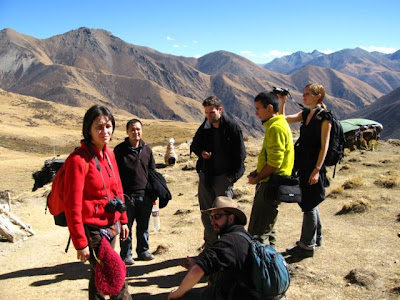
Anne, Atisha, Ephriam, Julia, Martin, Rita, and I went on a little weekend trip to the Ani Gompa at Terdron complete with hot springs and lots of beautiful hiking.
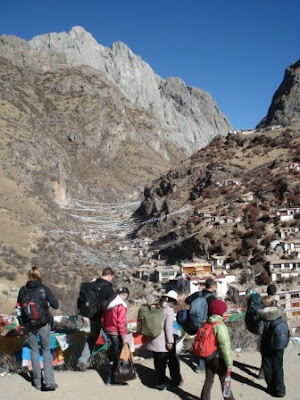 The bus ride isn't so hard and although it was quite cold when we left at 6am, by the time the bus dropped us above the Terdron ani gompa the sun had warmed the gray earth for our arrival. There were probably twenty multicolored jeeps parked closer to the Chinese hotel "newly" built near the fabled healing hot springs. The ani gompa seemed to be in a state of disrepair at first, but we found at least eight young carpenters hard at work on new furniture in front of the main chapel. We negotiated ticket prices and a large cold room with seven beds before heading to the gompay sakhang for noodles, rice, and, for the adventurous boys, our first experience of snuff. A friendly looking Tibetan, apparently unafraid of sitting near the "Chee Gyay" (foreigners, literally it means 'outside country'), offered Atisha a little "nose medicine" as he called it. Although it took some convincing, I also tried a little. It's not all it's cracked up to be.
The bus ride isn't so hard and although it was quite cold when we left at 6am, by the time the bus dropped us above the Terdron ani gompa the sun had warmed the gray earth for our arrival. There were probably twenty multicolored jeeps parked closer to the Chinese hotel "newly" built near the fabled healing hot springs. The ani gompa seemed to be in a state of disrepair at first, but we found at least eight young carpenters hard at work on new furniture in front of the main chapel. We negotiated ticket prices and a large cold room with seven beds before heading to the gompay sakhang for noodles, rice, and, for the adventurous boys, our first experience of snuff. A friendly looking Tibetan, apparently unafraid of sitting near the "Chee Gyay" (foreigners, literally it means 'outside country'), offered Atisha a little "nose medicine" as he called it. Although it took some convincing, I also tried a little. It's not all it's cracked up to be.Soon after lunch, we set off to find the famous caves of the Dakinis we knew were in the area.
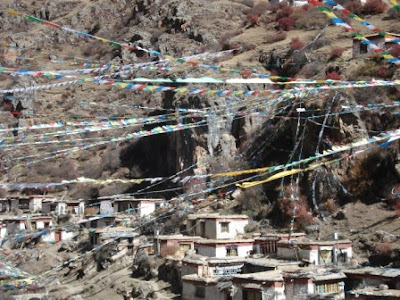 Jeanine's theory is that they used large arrows (perhaps with crossbows?) to shoot the prayer flags across the gorge. Some must have been thousands of feet long. They fluttered in the wind high above us as we hiked down and across the river and up the other side.
Jeanine's theory is that they used large arrows (perhaps with crossbows?) to shoot the prayer flags across the gorge. Some must have been thousands of feet long. They fluttered in the wind high above us as we hiked down and across the river and up the other side.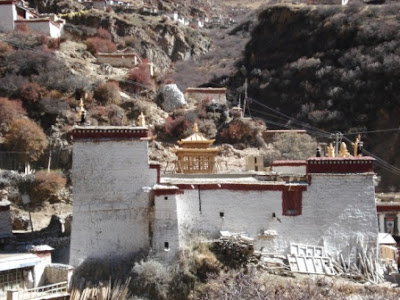 Some construction can be seen on the roof here. It appears that the nuns were either getting some big donations that the govt. allowed them to build with, or they were making plenty from charging for the hot springs. The place seemed quite busy, and, as there was a festival coming up, the buildings were being newly "painted". The painting process is surely unique to Tibetan culture. It basically involves rags covered in wet white chalk being slapped against rock until it turns sufficiently white, and it involves the painter being completely and comically covered in splattered white.
Some construction can be seen on the roof here. It appears that the nuns were either getting some big donations that the govt. allowed them to build with, or they were making plenty from charging for the hot springs. The place seemed quite busy, and, as there was a festival coming up, the buildings were being newly "painted". The painting process is surely unique to Tibetan culture. It basically involves rags covered in wet white chalk being slapped against rock until it turns sufficiently white, and it involves the painter being completely and comically covered in splattered white.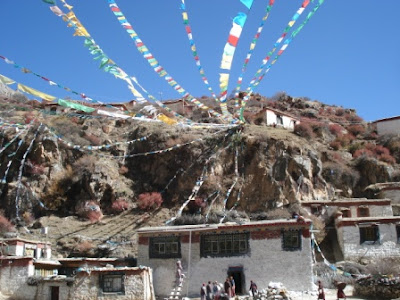 Nuns and locals at work.
Nuns and locals at work.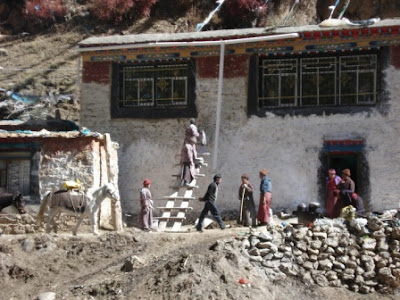 Here the horseman stops to watch the spectacle of the painter on his ladder battling the white stuff.
Here the horseman stops to watch the spectacle of the painter on his ladder battling the white stuff.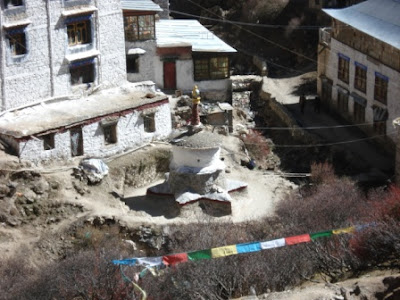 This six sided star holding up the small stupa is the first I have seen. Although I have noticed six sided stars and swastikas on various paintings or weavings, this Kora worthy object was quite a surprise.
This six sided star holding up the small stupa is the first I have seen. Although I have noticed six sided stars and swastikas on various paintings or weavings, this Kora worthy object was quite a surprise.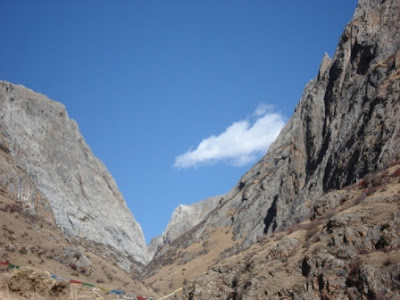 Lonely little cloud, from whence have you come?
Lonely little cloud, from whence have you come?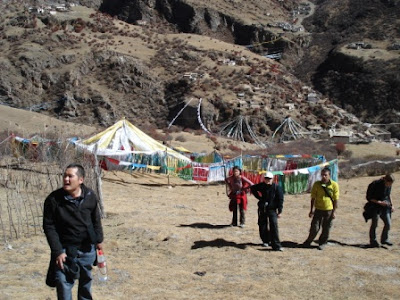 Not much oxygen to breath up here. Hey, is that a climbable boulder up there?
Not much oxygen to breath up here. Hey, is that a climbable boulder up there?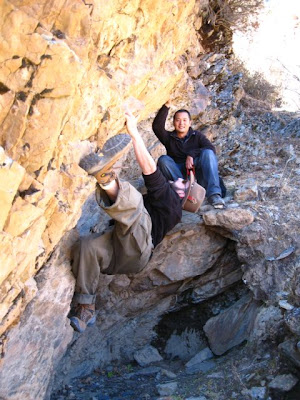 Sweet overhangs! But Ephriam, you can't simultaneously pose for the picture and spot me.
Sweet overhangs! But Ephriam, you can't simultaneously pose for the picture and spot me.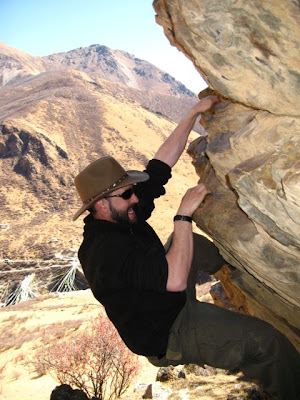 ggrrrrrrrrr.
ggrrrrrrrrr.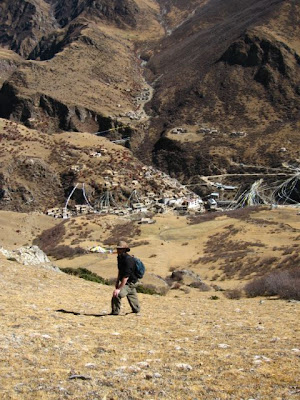 More hiking and more hiking...steeper and steeper and steeper. Did you know that some types of yak have shorter legs on one side because they have adapted to living on the sides of very steep mountains? Ha ha, some of you believed that for a second, didn't you.
More hiking and more hiking...steeper and steeper and steeper. Did you know that some types of yak have shorter legs on one side because they have adapted to living on the sides of very steep mountains? Ha ha, some of you believed that for a second, didn't you.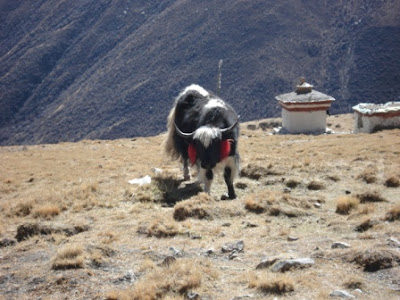 Holy YAK!
Holy YAK!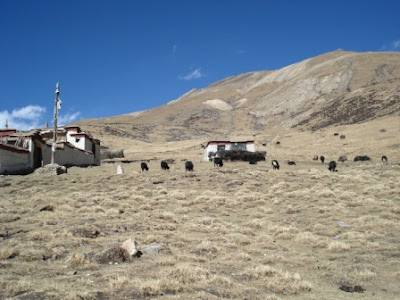 This is where we met a special nun who ordered us to learn Tibetan and only then study dharma. She also was quite adamant that Julia shave her head and become a nun, but I don't think that advice is going to be taken.
This is where we met a special nun who ordered us to learn Tibetan and only then study dharma. She also was quite adamant that Julia shave her head and become a nun, but I don't think that advice is going to be taken.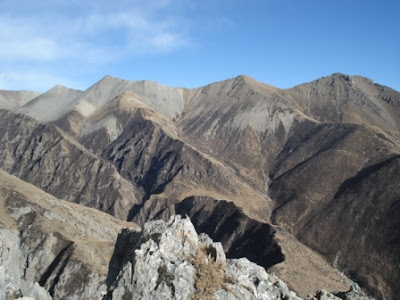 Somewhere around here we noticed that Ephriam and Rita had been gone for an hour and we couldn't hear or see them. We had been hiking for several hours and it had become so steep that going down looked like quite a scary prospect. Noticing that the sun would be setting soon, we decided some of us would go down to the valley and Martin and I would stay to search the mountain top for our errant friends.
Somewhere around here we noticed that Ephriam and Rita had been gone for an hour and we couldn't hear or see them. We had been hiking for several hours and it had become so steep that going down looked like quite a scary prospect. Noticing that the sun would be setting soon, we decided some of us would go down to the valley and Martin and I would stay to search the mountain top for our errant friends.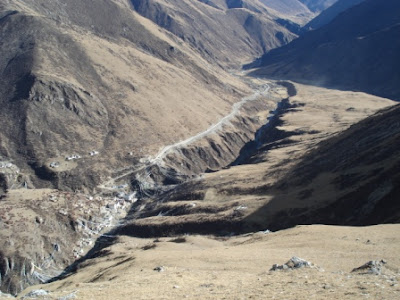 See the rooftop of the sakhang near the small stupa with a six sided star under it? Well, neither do I, but that is where Atisha and Julia were going to wave their bright colored coats in the air to indicate that they had either found Ephriam and Rita (yellow and red coats) or had not (red coat). Luckily it only took another half hour or so to find the lost sheep, who had been taking pictures on the summit and had confused the way back down. When we finally made it back it was getting dark and we soon found food and friends. Alice, Jeannine, Alice's sister and her boyfriend Greguar (sp? The first words he said to me were that he didn't expect me to be able to pronounce his name properly, Americans never can. He turned out to be an MIT alumni and a swell chap, in the end.) arrived from Lake Namtso, joining us just in time for a dip in the hot springs. After a nice warm bath eleven of us crammed into our seven person room and enjoyed some homemade chocolate cake and beer.
See the rooftop of the sakhang near the small stupa with a six sided star under it? Well, neither do I, but that is where Atisha and Julia were going to wave their bright colored coats in the air to indicate that they had either found Ephriam and Rita (yellow and red coats) or had not (red coat). Luckily it only took another half hour or so to find the lost sheep, who had been taking pictures on the summit and had confused the way back down. When we finally made it back it was getting dark and we soon found food and friends. Alice, Jeannine, Alice's sister and her boyfriend Greguar (sp? The first words he said to me were that he didn't expect me to be able to pronounce his name properly, Americans never can. He turned out to be an MIT alumni and a swell chap, in the end.) arrived from Lake Namtso, joining us just in time for a dip in the hot springs. After a nice warm bath eleven of us crammed into our seven person room and enjoyed some homemade chocolate cake and beer.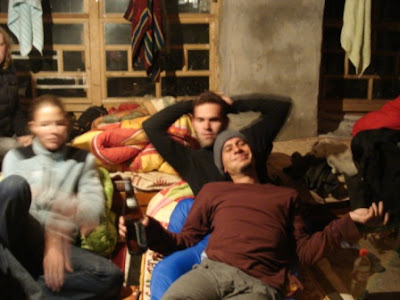 This is how Indians party.
This is how Indians party.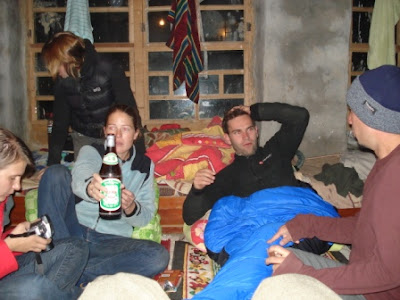 Rita (in the background): Ver is miy cam-er-a? Jeannine (on the left): And then there was this damn cat that followed us for four hours; wanna see its picture? Alice: Want some beer? Martin (to Atisha): Sheeet, You did what? Atisha: No, you are nut leestening man!
Rita (in the background): Ver is miy cam-er-a? Jeannine (on the left): And then there was this damn cat that followed us for four hours; wanna see its picture? Alice: Want some beer? Martin (to Atisha): Sheeet, You did what? Atisha: No, you are nut leestening man!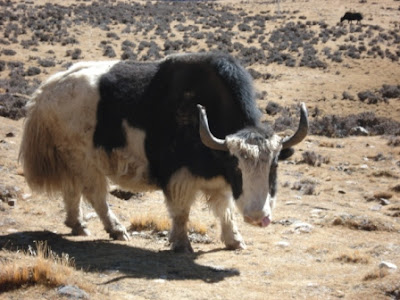 Mr. Yak says: "Eat your vegetables youngin !"
Mr. Yak says: "Eat your vegetables youngin !"Next day it was time to get an early ride to the Drikung Kagyu gompa, where we would be dropped off at the beginning of the large Kora that goes by the Drikung sky-burial site. Koras around gompas are not usually quite as strenuous, or as beautiful as the one around Drikung.
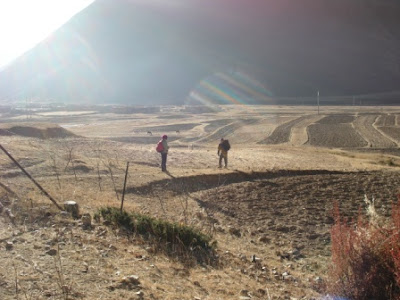 Atisha and Julia bringing up the rear in the early morning light.
Atisha and Julia bringing up the rear in the early morning light.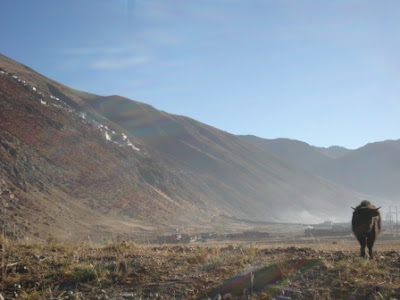 After passing the grazing yaks on the valley floor we started up the mountainside, ascending more than 300 meters to the top of the sky-burial site. The sun rose all around us, setting fire to the red shrubbery on the hillside.
After passing the grazing yaks on the valley floor we started up the mountainside, ascending more than 300 meters to the top of the sky-burial site. The sun rose all around us, setting fire to the red shrubbery on the hillside.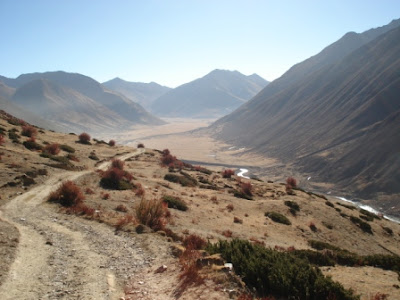 Nearing the sky-burial site.
Nearing the sky-burial site.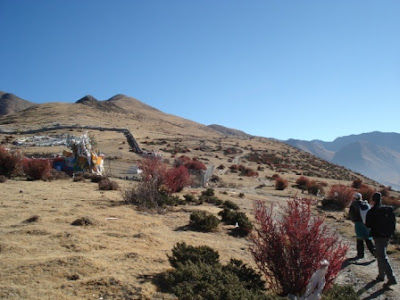 The large fence creating the huge rectangle on the mountainside is actually thousands of prayer flags. In the center of the rectangle is a circle of posts and prayer flags, presumably the site of the eating frenzy for the vultures. In the distance there are may small dark patches that appear to be shrubs. Easily half of them are huge (perhaps gargantuan is a better word) vultures. From where we had tea it looked like they were a pile of black rocks, but then they would begin to move along the ground. When Rita got close to take pictures she sent the lot of them into the air and they flew down across the burial site and right over our heads. There were hundreds of them.
The large fence creating the huge rectangle on the mountainside is actually thousands of prayer flags. In the center of the rectangle is a circle of posts and prayer flags, presumably the site of the eating frenzy for the vultures. In the distance there are may small dark patches that appear to be shrubs. Easily half of them are huge (perhaps gargantuan is a better word) vultures. From where we had tea it looked like they were a pile of black rocks, but then they would begin to move along the ground. When Rita got close to take pictures she sent the lot of them into the air and they flew down across the burial site and right over our heads. There were hundreds of them.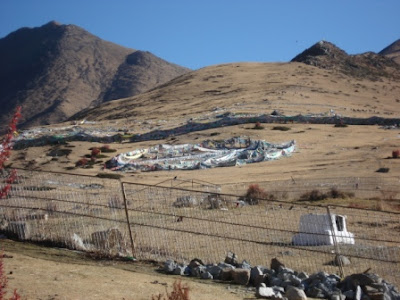 Here there was a partial fence, I believe it was partly around the area where a body would be dismembered in preparation for the vultures lunch.
Here there was a partial fence, I believe it was partly around the area where a body would be dismembered in preparation for the vultures lunch.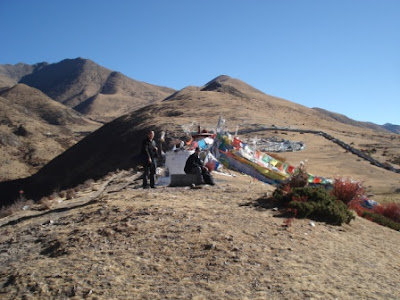 Here we had tea and chocolate looking over at the burial site.
Here we had tea and chocolate looking over at the burial site.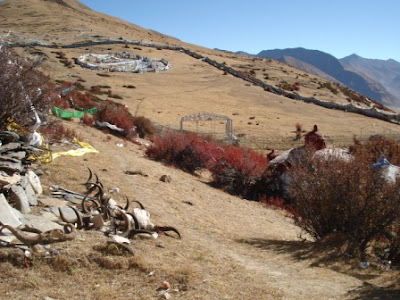 There were many bones and one might have thought the feeling of death was palpable. But it wasn't, not at all. It was quite comfortable and sunny.
There were many bones and one might have thought the feeling of death was palpable. But it wasn't, not at all. It was quite comfortable and sunny.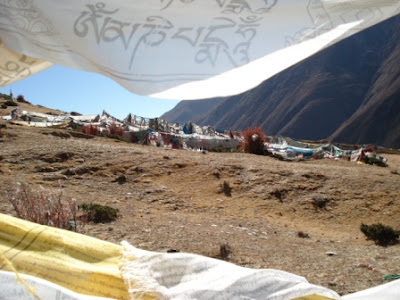 Looking through the mani-fence.
Looking through the mani-fence.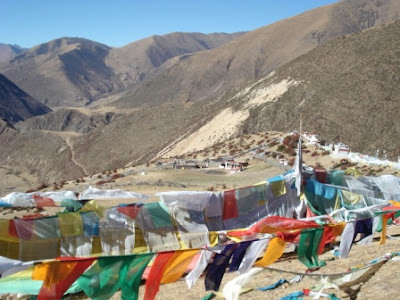
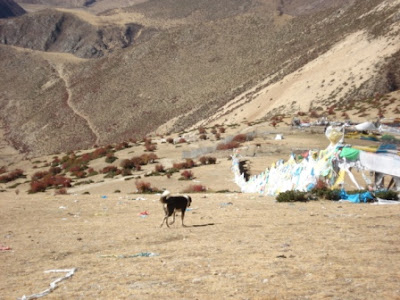 A dog in the dust.
A dog in the dust.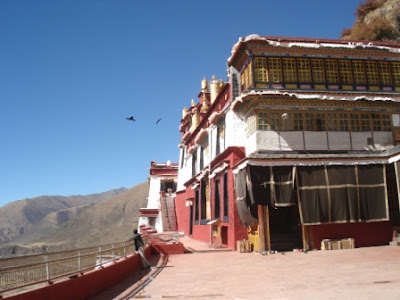 Finally arriving at Drikung.
Finally arriving at Drikung.The monastery is a huge town on the side of a steep mountain. It was quite hard to find our way down to the main courtyard from the sky-burial site far above the monastery.
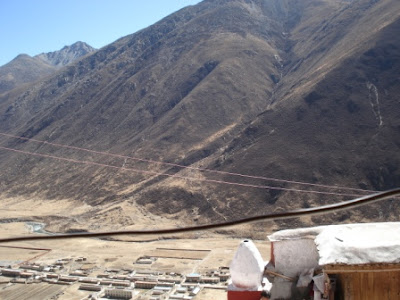 View from the monastery and from below as well:
View from the monastery and from below as well: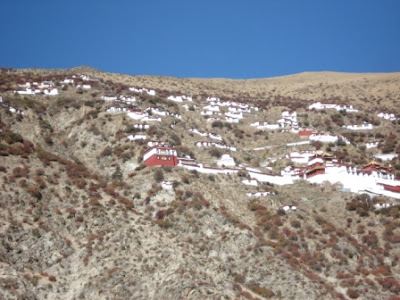
We had thukpa soup surrounded by pilgrims and beggars. We slowly found our way to the main shrine room where we were allowed to rest away from the sun for a bit.
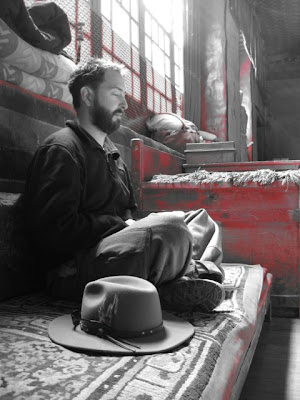
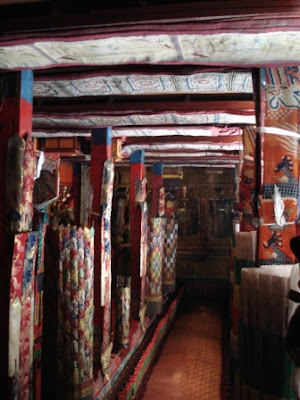
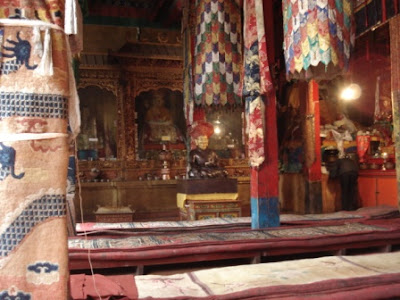
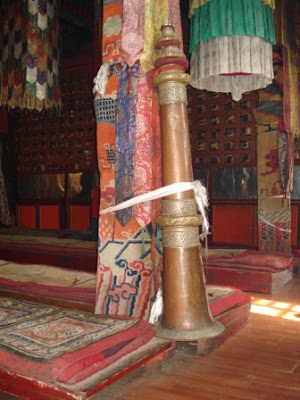
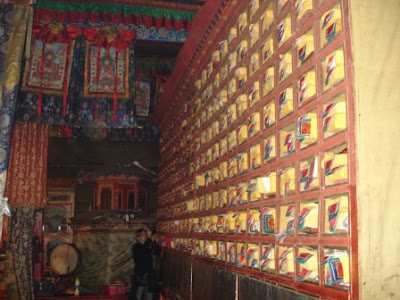 Rita trying to get the artsy photo.
Rita trying to get the artsy photo.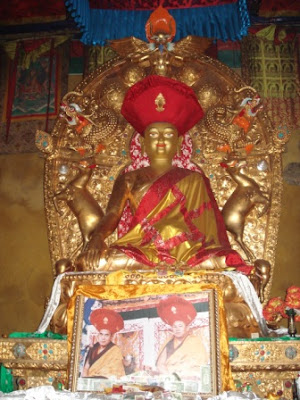 The Drikung lineage.
The Drikung lineage.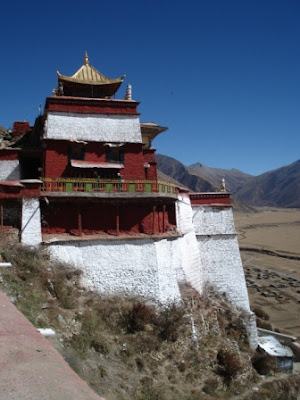 Ephriam convinced one of the monks to allow us to see all the LhaKhangs. Usually pilgrims come long before noon, and we didn't begin our exploration until at least 2pm.
Ephriam convinced one of the monks to allow us to see all the LhaKhangs. Usually pilgrims come long before noon, and we didn't begin our exploration until at least 2pm.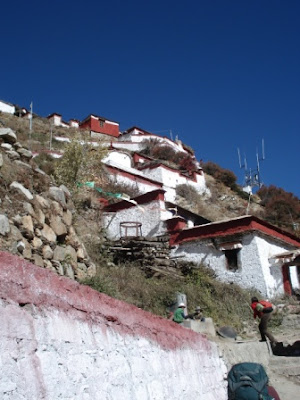
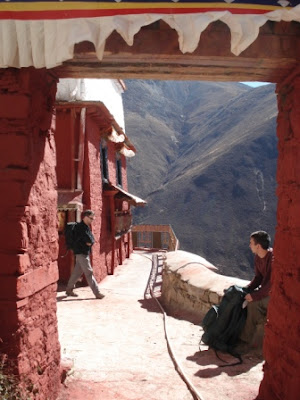 Resting between LhaKhangs (temples). We barely made it through the temples because everyone was so tired. But Ephriam goaded us along and we even scored a bus back to lhasa before dark.
Resting between LhaKhangs (temples). We barely made it through the temples because everyone was so tired. But Ephriam goaded us along and we even scored a bus back to lhasa before dark.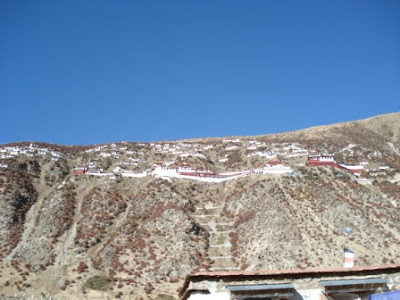 Bye bye Drikung!
Bye bye Drikung!Our trip was a great tiring success. I definitely plan to be back in the hot springs of Terdron before Christmas. Drikung I will probably not visit again unless I'm asked to. The place is beautiful but the feeling around the monks is quite odd. Perhaps they are under scrutiny from the PSB. There was an empty feeling that didn't sit well. But perhaps that was the thukpa.

1 comment:
Interesting to know.
Post a Comment